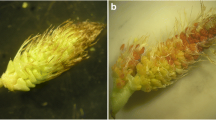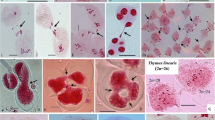Abstract
Intersubspecific autotetraploid rice hybrids have high heterosis in both vegetative and reproductive growth, but low seed set hinders commercial utilization of autotetraploid rice. Autotetraploid rice hybrids with high and low pollen fertility were used in the present study to compare microtubule distribution patterns and chromosome behavior during pollen mother cell (PMC) meiosis, using indirect immunofluorescence laser scanning confocal microscopy. Microtubule distribution patterns of autotetraploid hybrids were similar to diploid rice, but many different kinds of abnormalities were found in the hybrid with low pollen fertility and seed set. Abnormal microtubule organization including structurally distorted microtubules at pachytene, loosely knitted perinuclear microtubules at diakinesis during prophase I, and abnormal spindles, viz. multipoles, loss of spindle pole focus, abnormal size of spindles, and so on, were found at metaphase I and metaphase II. Some cells developed into triad with no formation of tetrad. Abnormal chromosome behaviors included high percentage of multivalents, chromosome lagging, chromosome bridges, and micronuclei. All these abnormalities were found more frequently in low-fertile hybrid than in high-fertile hybrid. These results suggest that abnormal microtubule distribution pattern is an important factor which affects pollen fertility and percentage seed set in autotetraploid rice, and may also have a close relationship with chromosome behavior.



Similar content being viewed by others
References
Chan A, Cande WZ (1998) Maize meiotic spindles assemble around chromatin and do not require paired chromosomes. J Cell Sci 111:3507–3515
Feng JH, Liu XD, Lu YG (1999) A preliminary study on microtubular cytoskeleton during microsporogenesis of rice. Journal of South China Agricultural University 20:1–5
Guo XP, Qin RZ, Chen X (2002) Factors affecting production of autotetraploid rice. J Plant Genet Res 3:30–33
Guo JY, Chen JF, Qian CT, Cao QH (2004) Meiotic chromosome pairing research and genome analysis in plants. Chinese Bull Bot 21:513–520
Hu CY, Zeng YX, Lu YG, Li JQ, Liu XD (2009) High embryo sac fertility and diversity of abnormal embryo sacs detected in autotetraploid indica/japonica hybrids in rice by whole-mount eosin B-staining confocal laser scanning microscopy. Plant Breed 128:187–192
Ishizaka H (2003) Cytogenetic studies in Cyclamen persicum, C. graecum (Primulaceae) and their hybrids. Pl Syst Evol 239:1–14
Janson ME, Setty TG, Paoletti A, Tran PT (2005) Efficient formation of bipolar microtubule bundles requires microtubule-bound γ-tubulin complexes. J Cell Biol 169:297–308
Khush GS (2003) Productivity improvement in rice. Nutrition Rev 61:114–116
Li ZM, Lin WJ (1988) Cytogenetics. Sichuan University Press, Sichuan, pp 226–227
Liu ZX, Qin RZ (1995) Cytological evidence for selecting a set of primary trisomics by using anther culture of autotetraploid rice. Scientia Agricultura Sinica 28:1–8
Liu XD, Lu YG, Zhu HL, Feng JH, Xu SX (2004) Abnormal behavior of nuclei and microtubule (MT) organizational changes during embryo sac development in the poly-egg mutant, APIV of rice. Acta Bot Sin 46:829–838
Long WB, Luan L, Wang X, Liu YH, Tu SB, Kong FL, He T (2007) Cytogenetical comparison of restorers TP-4 and D minghui63 and maintainer D46B of autotetraploid rice. Hereditas 29:462–470
Luan L, Tu SB, Long WB, Wang X, Liu YH, Kong FL, He T, Yan WG, Yu MQ (2007) Cytogenetic studies on two F1 hybrids of autotetraploid rice varieties showing extremely high level of heterosis. Pl Syst Evol 267:205–213
Luan L, Wang X, Long WB, Liu YH, Tu SB, Zhao ZP, Kong FL, Yu MQ (2008) Microsatellite analysis of genetic variation and population genetic differentiation in autotetraploid and diploid rice. Biochem Genet 46:248–266
Nonomura KI, Nakano M, Fukuda T, Eiguchi M, Miyao A, Hirochika H, Kurata N (2004) The novel gene homologous pairing aberration in rice meiosis1 of rice encodes a putative coiled-coil protein required for homologous chromosome pairing in meiosis. Plant Cell 16:1008–1020
Normile D (2008) Reinventing rice to feed the world. Science 321:330–333
Schmit AC, Endle MC, Lambert AM (1996) The perinuclear microtubule-organizing center and the synaptonemal complex of higher plants share a common antigen: its putative transfer and role in meiotic chromosome ordering. Chromosoma 104:405–413
Shahid MQ, Sun JF, Wei CM, Zhang P, Liu XD (2010a) Studies on the abnormality of embryo sac and pollen fertility in autotetraploid rice during different growing seasons. Pak J Bot 42:7–19
Shahid MQ, Liu GF, Li JQ, Naeem M, Liu XD (2010b) Heterosis and gene action study of agronomic traits in diploid and autotetraploid rice. Acta Agr Scand B-S P (in press)
Staiger CJ, Cande WZ (1990) Microtubule distribution in dv, a maize meiotic mutant defective in the prophase to metaphase transition. Dev Biol 138:231–242
Tang QX, Wang LH (2000) Progress study of plant microtubule. Plant Physiol Commun 36:158–164
Wang GW, He YQ, Xu CG, Zhang Q (2006) Fine mapping of f5-Du, a gene conferring wide-compatibility for pollen fertility in intersubspecific hybrids of rice (Oryza sativa L.). Theor Appl Genet 112:382–387
Wasteneys GO (2002) Microtubule organization in the green kingdom: chaos or self order? J Cell Sci 115:1345–1354
Wasteneys GO, Fujita M (2006) Establishing and maintaining axial growth: wall mechanical properties and the cytoskeleton. J Plant Res 119:5–10
Wasteneys GO, Galway ME (2003) Remodeling the cytoskeleton for growth and form: an overview with some new views. Annu Rev Plant Biol 54:691–722
Xiao B, Liu XD, Lu YG, Li JQ, Zhao XJ (2005) Structure of embryo sac and fertilization in intersubspecific hybrids of autotetraploid rice. Acta Agron Sin 31:1150–1156
Xu SX, Ye XL (1998) Changes in the pattern of organization of microtubules during microspore formation in rice (Oryza sativa L.). Acta Bot Sin 40:585–590
Xu SX, Liu XD, Feng JH, Lu YG (2001) Comparative studies on the changes of microtubule distribution and reorganization during the meiotic stages of development in normal (IR36) and a temperature/photoperiod sensitive male sterile line (Peiai 64S) of Rice (Oryza sativa). Acta Bot Sin 43:221–226
Yang M, Ma H (2001) Male meiotic spindle lengths in normal and mutant Arabidopsis cell. Plant Phys 126:622–630
Ye XL, Yeung E, Xu SX, Liang C (2003) Microtubule structure and male sterility in a gene-cytoplasmic male sterile line of rice, Zhen Shan 97A. Acta Bot Sin 45:183–192
Zhang D, Nicklas RB (1995a) Chromosome initiate spindle assembly upon experimental dissolution of the nuclear envelope in grasshopper spermatocytes. J Cell Bio 131:1125–1131
Zhang D, Nicklas RB (1995b) The impact of chromosomes and centrosomes on spindle assembly as observed in living cells. J Cell Bio 129:1287–1300
Zhang HH, Feng JH, Lu YG, Yang BY, Liu XD (2003) Observation on the formation and development of autotetraploid rice embryo sac using laser scanning confocal microscopy. J Chin Electron Microsc Soc 2:380–384
Zhao MH, Liu XD, Lu YG, Li JQ, Guo HB (2006) Chromosome pairing behavior and reproduction in the hybrid developed by the interaction of different pollen sterile genes in autotetraploid rice. Acta Agron Sin 32:1472–1478
Zhu Z, Xu SX (1996) Plant cytoskeleton. Peking Science, Beijing
Acknowledgments
The authors thank Dr. Li Jin-Quan, Fu Xue-Lin, and Assc. Prof. Yang Bing-Yao, Su Wei, Ms Yu Shu-Hong, and Zhao Xing-Juan for their help in the laboratory and field. This research was supported by the National Science Foundation of China (30771328) and Joint Fund of the National Natural Science Foundation of China, Guangdong Province (Grant No. U0631003).
Author information
Authors and Affiliations
Corresponding authors
Rights and permissions
About this article
Cite this article
He, JH., Shahid, M.Q., Chen, ZX. et al. Abnormal PMC microtubule distribution pattern and chromosome behavior resulted in low pollen fertility of an intersubspecific autotetraploid rice hybrid. Plant Syst Evol 291, 257–265 (2011). https://doi.org/10.1007/s00606-010-0386-y
Received:
Accepted:
Published:
Issue Date:
DOI: https://doi.org/10.1007/s00606-010-0386-y




